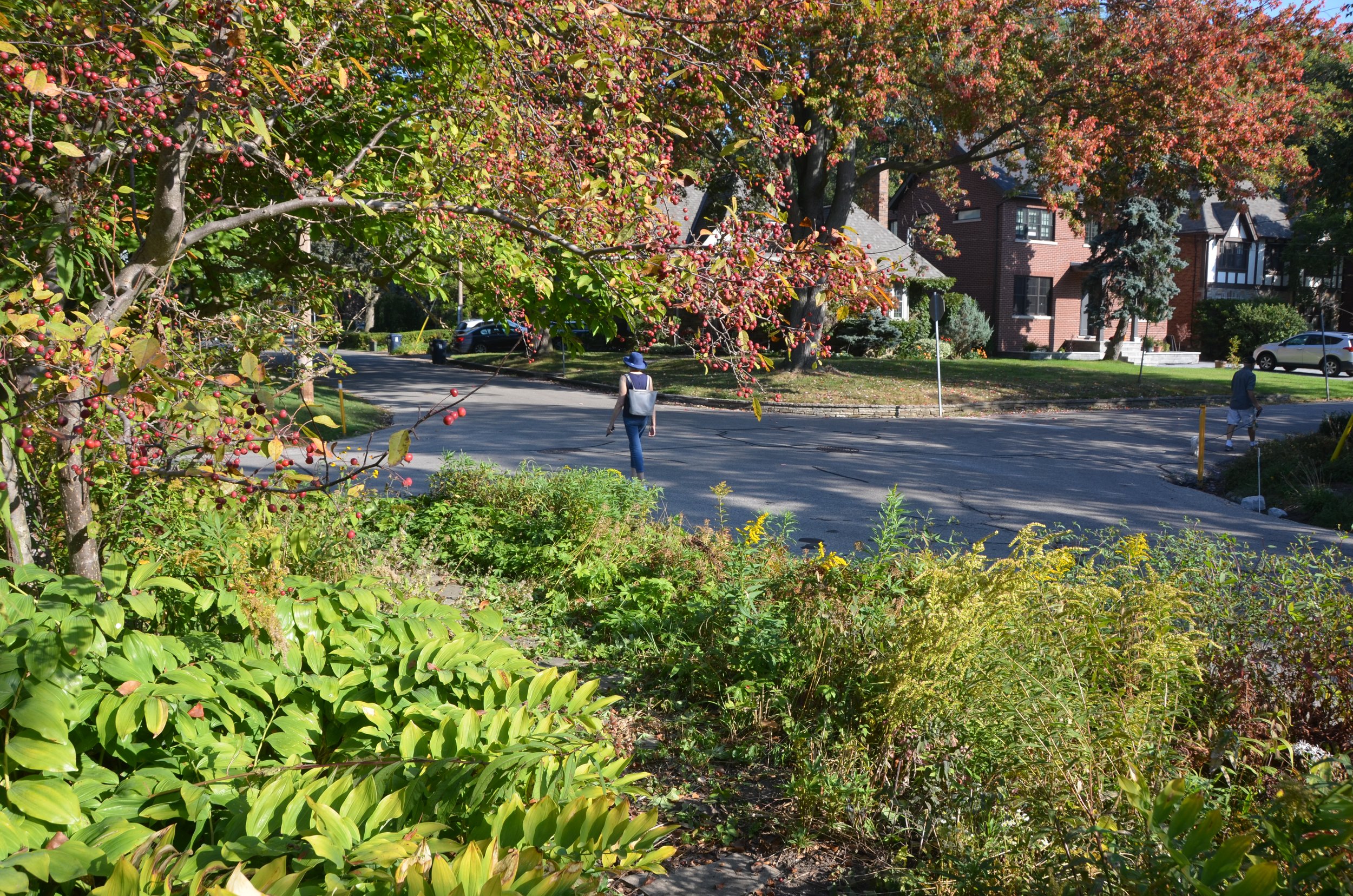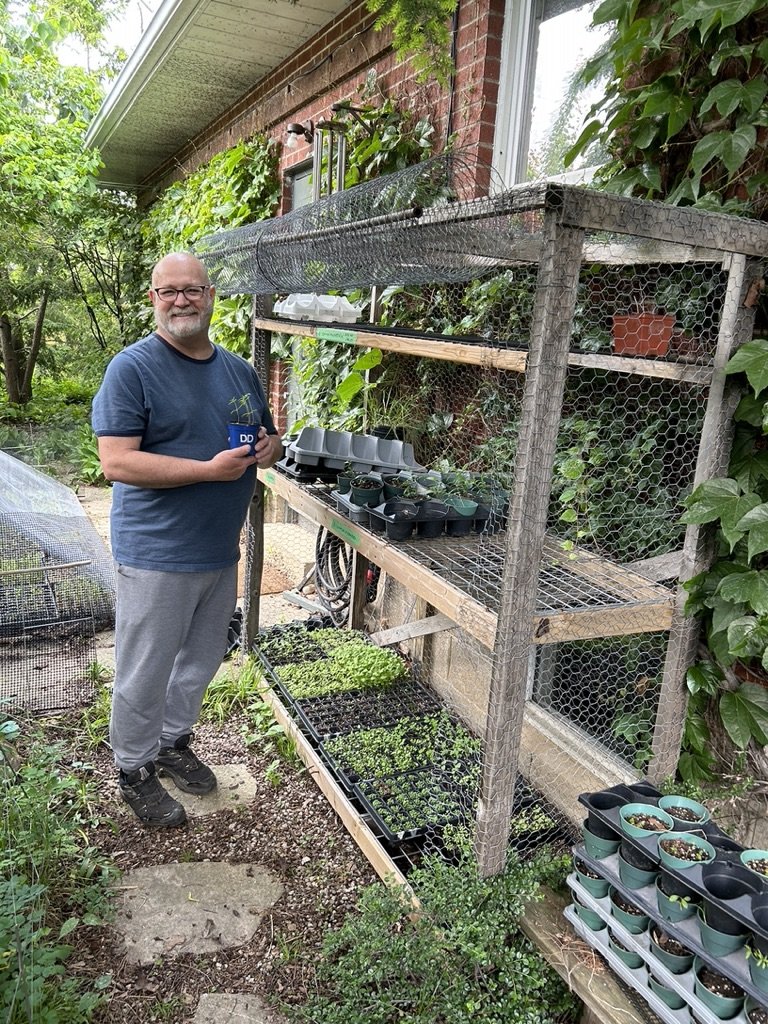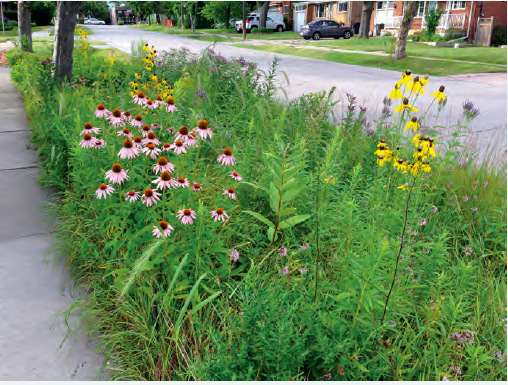Below is an open letter to municipalities, written by the Canadian Society of Landscape Architects, the Canadian Wildlife Federation, the David Suzuki Foundation, the Ecological Design Lab, and me, that we ask you to download (click on the black button at the end of the post) and send to your Councillor and Mayor. We are advocating for the reform of outdated “grass and weeds” bylaws and enforcement practices that place barriers in the way of cultivating habitat gardens.
Oak Garden Ordered Cut
Eric Davies is one of Toronto’s most vocal advocates for the heritage oak trees that have managed to survive in this rapidly developing urban environment. For more than a decade, Eric has been collecting and propagating acorns from the city’s oldest oak trees and giving young trees to community projects, schools, residents’ associations, Indigenous land stewards, neighbours—basically, anyone who’s concerned about Toronto’s urban forest and wants to grow trees for the future.
Ironically, the mini-forest Eric has planted in front of the apartment building where he lives in Toronto’s west end is now under threat. The City has issued a Notice of Violation, ordering the vegetation—oak saplings and native perennials—cut to below 0.85 metres and the removal of the 100-year-old red oak log Eric salvaged, with permission, from the City’s forestry facility and that serves as a welcoming neighbourhood bench for passersby.
According to the Notice of Violation, the vegetation is “obstructing/encumbering/damaging/fouling” the street and the “decorative log” causes an “obstruction/nuisance/dangerous condition.”
Like most front-yard gardens in the city, Eric’s planting is on the municipal right-of-way, what’s known as the street allowance, which in small Toronto yards can extend to the porch or house. Perhaps most residents who garden in their small front yards aren’t aware that a significant portion of their planting is actually an encroachment. Indeed, most gardeners care for these right-of-way spaces with impunity. In Eric’s case, most likely someone complained. This triggered an inspection, a Notice of Violation, and an order to cut the trees and plants down to 0.85 metres within seven days or face “further enforcement measures,” including a fine.
Given the City’s goal of increasing the tree canopy to 40 per cent by 2050, one might expect that Eric’s mini-forest would be embraced, not threatened with destruction. Along with his own front-yard contribution to the tree canopy, Eric has given away thousands of oak trees for others to plant. But the value of what he’s doing goes far beyond numbers alone: by propagating acorns from the city’s old-growth oaks, he is preserving the irreplaceable genetics of heritage trees before they succumb to old age, the degraded conditions of the city’s ravines and natural areas, and to development. Eric is a champion of the future forest, preserving through propagation the unique adaptations to local conditions that these oak trees contain in their genetic make-up. Climate change and biodiversity loss add urgency to the crucial work Eric is doing.
The order to cut down to 0.85 metres the oak saplings and the dozens of native perennials Eric has planted with them and that naturally grow in association with oak trees, is an order to cut down a regenerating oak ecosystem. This ecosystem has much in common with the rare oak savanna in High Park, which the City has committed to protecting. Eric’s planting is one piece in what could be—should be—a matrix of oak ecosystem protection in the city.
The Notice of Violation would be understandable if the planting interfered with sightlines or if the log obstructed passage on the sidewalk. But they don’t. The planting is set back at least 1.2 metres and the log 30 to 38 cm from the sidewalk. The sightlines are clear. Nearby are large City-planted street trees throughout the neighbourhood, and gardens with plants higher than 0.85 metres in the municipal road allowance. As with Eric’s planting, there is safety, the ability to see past the trees, and there is carefully nurtured growth.
The City recently revised its “grass and weeds” bylaw in an effort to support biodiversity and naturalized yards. Eric’s is a banner project in support of these twin, connected goals. Unfortunately, it’s also a banner example of how bylaw enforcement continues to be a problem—whether through the mistaken identification of native plants as prohibited plants or, as in Eric’s case, claiming his front-yard garden is an encroachment.
Now that the City has updated its “grass and weeds” bylaw, what needs changing are bylaw enforcement policies. Quite simply, the City needs to stop placing barriers and threatening to punish those who are trying to protect our collective future.
(Photo by Lorraine Johnson, October 3, 2023)
"All this should go" says Toronto bylaw officer
The Violation Notice for the native plant garden in the photo above.
The native plant garden in the photo above received a Violation Notice from a Toronto bylaw officer on October 1, 2023. The following are direct quotes, captured on a security camera, from the conversation between the gardener’s son and the bylaw officer. (The full conversation is roughly 5 minutes and includes a bit more of the same.)
Bylaw Officer: “I want you to cut the grass and weeds.”
Gardener’s son: “It’s not weeds. This is a native plant garden, no weeds anywhere. This is all Ontario native plants.”
Bylaw Officer: “Well, you have to clean it underneath.”
Gardener’s son: “Underneath? What’s wrong with this?”
Bylaw Officer: “It’s weeds.”
Gardener’s son: “No weeds! This is strawberries.”
Bylaw Officer: “This is not the way…”
Gardener’s son: “What do you mean? None of this is weeds.”
Bylaw Officer: “Unless you have proof…documentation that you are allowed to have this, you have to clean it out [in] 10 days.”
Gardener’s son: “All of it?!”
Bylaw Officer: “Yes”
Gardener’s son: “How high?”
Bylaw Officer: “20 centimetres. Everything should be down. When you cut it down to 20 centimetres, take pictures and send them to my email.”
Gardener’s son: “What does the law say? If this is a native plant garden, is it okay?”
Bylaw Officer: “No, unless you have documentation that this is a native plant garden and you are allowed to have it, you have to clear it to 20 centimetres.”
Gardener’s son: “What are the Prohibited Plants? How is it prohibited if it’s all native plants? I’m confused.”
Bylaw Officer: “I don’t know. I’m not an expert.”
Gardener’s son: “What about the trees and shrubs?”
Bylaw Officer: “This tree we can allow, but you have to clean underneath. All this should go.”
(Photo by Lorraine Johnson, October 2, 2023)
(Photo by Lorraine Johnson, October 3, 2023)
[It’s important to note that Toronto’s Turfgrass and Prohibited Plants bylaw lists 10 Prohibited Plants and does not include a provision regarding “documentation” or “approval” of gardens, whether native plant gardens or any other kind of garden.]
[I also want to stress that my intention is not to target or belittle this individual bylaw officer. There is a systemic problem and it needs to be addressed at a policy level. The exchange quoted above is a symptom of a broken system that will only change if we advocate for policy changes around bylaw enforcement.] For more info on advocacy, visit the Ecological Design Lab’s website section on Bylaws for Biodiversity: https://ecologicaldesignlab.ca/project/by-laws-for-biodiversity/
Douglas Counter’s native plant garden in Etobicoke. (Photo by Douglas Counter)
Despite a Court Victory, the Douglas Counter Saga Continues...
Douglas Counter is exactly the sort of gardener and volunteer that the City of Toronto’s PollinateTO program is intended to support and encourage. Not only has he created a native plant habitat garden in his front yard, backyard and boulevard, but he regularly offers community tours, sharing his knowledge and inspiring countless others to grow habitat in their yards, balconies and community projects. Even more, he is a native plant propagator extraordinaire, growing and giving away thousands of native plant seedlings to gardeners (through PollinateTO and Project Swallowtail), making it easy, low cost and do-able for others to get started on their habitat journeys.
Douglas Counter with some of the thousands of native plants he propagates and donates to gardeners. (Photo by Lorraine Johnson)
On August 16, 2023, the very day that Douglas was giving a tour of his native plant garden to City staff from the PollinateTO program and receiving accolades for his work, the bylaw enforcement office received a complaint about the “tall grass and weeds” in Douglas’ garden. (The “tall grasses” are native grasses and there are no Noxious Weeds in his intentionally planted and maintained 20+-year-old native plant garden.)
A few weeks later, Douglas received an Advisory Notice from the City, asserting that his native plant garden was in violation of the grass and weeds bylaw.
The irony of the City’s Advisory Notice goes beyond the fact that Douglas’ garden is promoted as a stellar example of a pollinator garden by one department of the City at the same time as another department is threatening the garden as a violation of the grass and weeds bylaw.
To understand the full extent of the irony, one needs to go back to the early 2000s, when Douglas took the City to court over their threat to mow down his native plant garden. Douglas won the court case. The judge ruled that the grass and weeds bylaw violated his constitutionally protected right to a “natural garden.” The court decision also affirmed the right to create a “natural garden” on the public right of way of the boulevard, subject only to health and safety restrictions.
Douglas Counter’s court case affirmed the right of gardeners to express their environmental beliefs on the public right of way of boulevards, subject only to health and safety restrictions. (Photo by Douglas Counter)
And yet, this summer, under a new and supposedly improved grass and weeds bylaw in Toronto, flawed enforcement continues. If winning a court case won’t stop this, what will?













